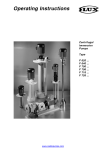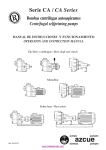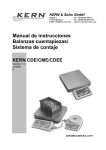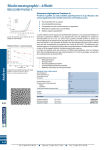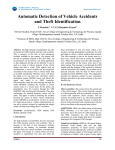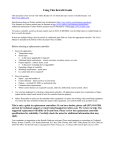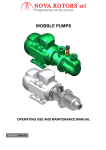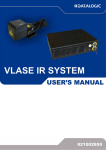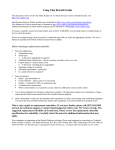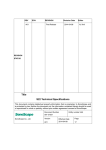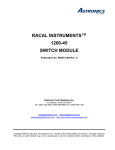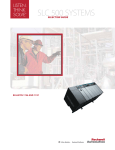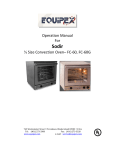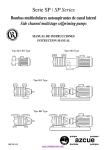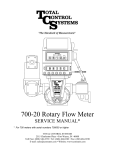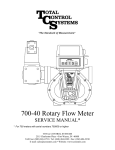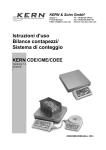Download Manual - Castle Pumps
Transcript
OPERATING, USE AND MAINTENANCE INSTRUCTIONS FOR PROGRESSING CAVITY PUMPS SERIES : DIAMOND CONSTRUCTION TYPE : OMI.EN-PCP.001 R00 DN / JN DH / JH 02/02/2011 www.castlepumps.com Page 1 1 INTRODUCTION This manual contains instructions for the correct use and maintenance of the Diamond Series progressing cavity pumps manufactured by NOVA ROTORS S.r.l. . The information contained in this manual is intended for the user who is required to read it carefully and to ensure that he has fully understood it before operating the machine. The user manual must be available for ready consultation at all times. If the manual is lost or damaged contact the manufacturer for a replacement copy. WARNING – The manufacturer is not liable for consequences resulting from an imprudent use of the machine due to the user’s failure to read this manual or incomplete reading of it. The manual is an integral part of each pump and consequently must be kept throughout the entire service life of the machine and accompany it at all times, even if transferred to another user. This manual contains instructions required for the safety, receiving, installation, storage, correct operation and maintenance of the Diamond Series progressing cavity pumps. WARNING. NOVA ROTORS S.r.l. reserves the right to modify the specifications referred to in this manual or the characteristics of each machine. Some of the illustrations in this manual may include parts that are slightly different to those mounted on your machine. 2 EC CONFORMITY Each machine is accompanied by an EC Declaration of Conformity signed by the legal representative of NOVA ROTORS S.r.l. The declaration of conformity states the pump model, serial number and order reference. The pump has been constructed in compliance with the essential health and safety requirements laid down in the following applicable directives: Machinery Directive: 2006/42/EC Low Voltage Directive: 2006/95/EC Electromagnetic Compatibility Directive. The following harmonised standards were also consulted for the design and construction of the pumps: UNI EN 809: 2009 – Pumps and pump units for liquids – Common safety requirements. UNI EN ISO 12100-1:2005 - Safety of machinery. Basic concepts, general principles for design. Part 1 : Basic terminology, methodology. UNI EN ISO 12100-2:2005 - Safety of machinery. Basic concepts, general principles for design. Part 2 : Technical principles. CEI EN 60204-1: 2005 – Safety of machinery - Electrical equipment of Machines. Part 1: General rules. WARNING. This declaration is only valid if the machine is installed, used and maintained in compliance with the above mentioned directives and instructions and with the instructions and equipment described in this manual. Pag.2 02/02/2011 www.castlepumps.com OMI.EN-PCP.001 R00 Indice 1 INTRODUCTION ...........................................................................................................................................................................2 2 EC CONFORMITY .........................................................................................................................................................................2 3 SYMBOLS .....................................................................................................................................................................................5 4 SAFETY.........................................................................................................................................................................................6 4.1 Failure to comply with safety standards .................................................................................................................................6 4.2 Start up, operation and maintenance .....................................................................................................................................6 4.3 Intended conditions of use ....................................................................................................................................................6 4.4 Pumps intended for use in potentially explosive atmospheres ...............................................................................................6 4.5 Safety guidelines relating to maintenance, inspection and assembly work ............................................................................7 4.6 Arbitrary production and transformation of spare parts ..........................................................................................................7 4.7 Noise ....................................................................................................................................................................................7 4.8 Leakage of hazardous fluids..................................................................................................................................................7 4.9 Protective clothing .................................................................................................................................................................7 4.10 Machine maintenance ...........................................................................................................................................................7 5 GENERAL .....................................................................................................................................................................................8 5.1 Main technical features of progressing cavity pumps .............................................................................................................8 5.2 Pump operating principle.......................................................................................................................................................8 5.3 Structure of the pump ............................................................................................................................................................8 5.4 Pumps with bypass ...............................................................................................................................................................9 5.5 Safety / pressure relief / check valves .................................................................................................................................10 5.6 Dry run protection................................................................................................................................................................10 5.7 6 Drive ...................................................................................................................................................................................10 JOB IDENTIFICATION.................................................................................................................................................................11 6.1 Product identification ...........................................................................................................................................................11 6.2 Technical specifications and documentation........................................................................................................................11 6.3 Standard Data Plate ............................................................................................................................................................12 6.4 Atex Data Plate ...................................................................................................................................................................12 6.5 Model identification .............................................................................................................................................................13 7 INSTALLATION AND ASSEMBLY ...............................................................................................................................................14 7.1 Positioning of the pump .......................................................................................................................................................14 7.2 Alignment of the coupling joint (Type J) ...............................................................................................................................14 7.3 Mounting the pump .............................................................................................................................................................15 7.4 8 8.1 Packing and transport .........................................................................................................................................................16 8.2 Storage ...............................................................................................................................................................................17 9 10 Pipe assembly.....................................................................................................................................................................15 TRANSPORT AND STORAGE ....................................................................................................................................................16 START UP PROCEDURES .........................................................................................................................................................18 9.1 Preparation for start up........................................................................................................................................................18 9.2 Direction of rotation .............................................................................................................................................................18 9.3 Delivery pressure check ......................................................................................................................................................19 9.4 Suction pressure check .......................................................................................................................................................19 9.5 Drives .................................................................................................................................................................................19 9.6 Electrical connections .........................................................................................................................................................19 MAINTENANCE ...........................................................................................................................................................................20 10.1 Wear and tear of parts:........................................................................................................................................................20 10.1.1 Rotor and Stator .......................................................................................................................................................................... 20 10.1.2 Joint and Drive Shaft ................................................................................................................................................................... 20 10.1.3 Seal ............................................................................................................................................................................................. 21 10.1.4 Bearing housing .......................................................................................................................................................................... 21 10.2 Pump Disassembly .............................................................................................................................................................21 OMI.EN-PCP.001 R00 02/02/2011 www.castlepumps.com Pag.3 10.3 Disassembly of the joints.....................................................................................................................................................23 10.4 Disassembly of connections to the close coupled arrangement and seals ...........................................................................25 10.4.1 Procedure for single mechanical seal G0K9 (STANDARD) / Q0K9 .............................................................................................. 25 10.4.2 Procedure for gland packing seal B01 / B02 ................................................................................................................................ 26 10.4.3 Procedure for back-to-back double mechanical seal D0K9 / D0S9 .............................................................................................. 26 10.4.4 Procedure for tandem doble mechanical seal K0K9 / K0S9 ......................................................................................................... 27 10.5 Pump assembly ..................................................................................................................................................................29 10.6 Joint assembly ....................................................................................................................................................................30 10.7 Assembling the seal and close coupled arrangement connections ......................................................................................33 10.7.1 Procedure for single mechanical seal G0K9 (STANDARD) / Q0K9 .............................................................................................. 33 10.7.2 Procedure per gland packing seal B01 / B02 ............................................................................................................................... 33 10.7.3 Procedure for back-to-back double mechanical seal D0K9 / D0S9 .............................................................................................. 34 10.7.4 Procedure for tandem double mechanical seal K0K9 / K0S9 ....................................................................................................... 35 10.8 1 Bearing housing module (Type J) ........................................................................................................................................36 10.8.1 Disassembly of the bearing housing ............................................................................................................................................ 36 10.8.2 Assembly of the bearing housing ................................................................................................................................................. 37 TROUBLESHOOTING TABLE .....................................................................................................................................................39 2 SPARE PARTS............................................................................................................................................................................40 2.1 Pump parts .........................................................................................................................................................................40 2.2 Spare parts for bearing housing ..........................................................................................................................................46 2.3 Seal systems: technical drawings and spare parts ..............................................................................................................52 2.3.1 Gland packing seal B01.................................................................................................................................................................... 52 2.3.2 Gland seal with flushing B02 ........................................................................................................................................................... 53 2.3.3 Single mechanical seal G0K9 ........................................................................................................................................................... 54 2.3.4 Single mechanical seal with quench Q0K9 ....................................................................................................................................... 55 2.3.5 Back-to-back double mechanical seal D0K9 / D0S9 ......................................................................................................................... 56 2.3.6 Tandem double mechanical seal K0K9 / K0S9 ................................................................................................................................. 57 Pag.4 02/02/2011 www.castlepumps.com OMI.EN-PCP.001 R00 3 SYMBOLS Danger warning Electrical hazard General warning indicating the potential risk of personal injury Electrical hazard indicating the potential risk of personal injury Danger: suspended load Caution: corrosive material Rotating parts hazard Do not remove safety guards from rotating parts Do not repair or oil machine whilst in motion This symbol draws your attention to the information Wear suitable clothing Wear protective gloves OMI.EN-PCP.001 R00 02/02/2011 www.castlepumps.com Pag.5 4 SAFETY 4.1 Failure to comply with safety standards Failure to comply with the safety standards described in this manual and those relating to common sense can cause danger to people and the environment and damage the machine. Specifically, such nonobservance can cause: inability of machine and/or plant to perform key functions; damage to the machine and /or plant ; electrical, mechanical and/or chemical danger to persons; environmental danger due to leakage of hazardous substances.. Failure to observe and comply with these safety standards will invalidate the warranty and lead to the loss of any compensation for damages. Keep these instructions and all related documents together, ensure that they are legible and easily accessible to all employees. Do not remove any safety equipment before operating the system or during its operation. Make sure that there is no evident danger before powering up the system. The system must be inspected regularly to check for damage and to ensure that all safety devices are in good working order. The pump contains moving parts. Do not insert limbs or materials other than the processing material while the pump is functioning. In the event of malfunction, danger or lack of appropriate safety systems, shut down the pump immediately and inform the qualified personnel. 4.2 Start up, operation and maintenance The plant designated to receive the progressing cavity pump is non an integral part of the supply, consequently the customer is required to verify the suitability of the machine for his specific needs, to provide the necessary processing data for a correct selection of the pump type and the accessories needed to guarantee the safety of the plant. If the user notices that any accessories he considers useful or essential are missing in the order confirmation, it is the customer’s responsibility to contact the manufacturer and request that the accessory or accessories be applied to the machine. While the pump is being used the safety devices provided must be present and correctly installed on the machine. Do not carry out any operation on the safety devices while the pump is operating. 4.3 Intended conditions of use Progressing cavity pumps are designed for pumping fluids of the type specified in the order. The pump must always observe the operating limitations for which it was constructed and those stated in the order confirmation: observe the temperature, pressure, capacity, viscosity and speed limits. Unless otherwise stated in the order, the pump must not be used in environments subject to the formation of potentially explosive atmospheres. 4.4 Pumps intended for use in potentially explosive atmospheres If the pumps are intended for use in potentially explosive atmospheres the fact must be specified in the order and the Atex mark included on the data plate. The ATEX directives concern controlling potentially explosive atmospheres and the standards for accessories and protection systems to be used in these atmospheres. Atex Directive 2006/42/EC applies specifically to electrical and non-electrical accessories. The conditions of use must fall within the boundaries that are defined and described in the directive. Personnel must comply with the following requirements and rules when working with products have Ex approval in potentially explosive atmospheres: • All actions on the product must be carried out by licensed electricians or authorised operators. Specific rules apply to installations in explosive atmospheres. • All users must be aware of electricity-related hazards and the chemical and physical characteristics of the gas and/or steam present in hazardous areas. • When you start up the machine, or carry out maintenance, controls or repairs on the machine consider your safety at all times, consequently adhere strictly to the general European directives on machinery that have been transposed into national laws, to Euronorm EN 12100:2005, to the specific safety standards and the pertinent technical rules. Pag.6 02/02/2011 www.castlepumps.com OMI.EN-PCP.001 R00 4.5 Safety guidelines relating to maintenance, inspection and assembly work The user must ensure that all maintenance, inspection and assembly operations related to the progressing cavity pumps are carried out by qualified technicians. Technicians must carefully read this instruction manual before acting on the pump. Only authorised and trained personnel are permitted to work on the progressing cavity pump. 4.6 Arbitrary production and transformation of spare parts Changes or modifications to the machine, within the limits that do not go beyond extraordinary maintenance, are only permitted if agreed on beforehand with the manufacturer. Only original spare parts or parts specifically declared as compatible by NOVA ROTORS S.r.l. must be used for regular maintenance operations. These parts have been designed specifically for the system. There is no guarantee that non-original parts can withstand the loads, and function correctly and safely. The use of non-original parts voids the warranty immediately. 4.7 Noise The A-weighted sound power level emitted by the machine does not exceed 85dB(A). This value is guaranteed if the pump is installed correctly, that is, in stable conditions with appropriate fastenings and measured at a distance of 1 metre from the pump. It does not include external noise sources or reverberation of the tubes connected to the pump while it is operating. Moreover, Nova Rotors does not guarantee this value if the machine is used in work conditions that do not comply with those specified in the work order and declared in the order confirmation. 4.8 Leakage of hazardous fluids If the pump is used to pump hazardous liquids (toxic, corrosive, etc...), the volumes of fluid that leak through the seals must be collected and disposed of without endangering human health or the environment. 4.9 Protective clothing Wear appropriate protective clothing to protect body parts. Safety gloves Wear suitable gloves to protect your hands from various types of possible hazards: mechanical, electrical, chemical and high temperatures. Clothing and footwear Wear appropriate clothing and safety footwear to protect your feet from falling objects. 4.10 Machine maintenance Do not disassemble the pump before emptying the tubes. Even if the tubes are all empty, some liquid could remain in the pump. The pumped fluid can be hazardous to human health and the environment, and can be very hot. All maintenance work must be carried out with the machine shut off from the power supply. Before beginning maintenance on the pump remember to disconnect the power supply by means of the circuit breakers. All the devices must be secured against automatic or accidental restart. (Where possible turn the main switch to OFF and remove the key). In particular situations where you need to run the pump while servicing at least 2 persons must be present so that in the event of danger one person will be able to disconnect the power supply or raise the alarm. Once maintenance has been completed remember to restore the safety devices and check that they are in good working order. OMI.EN-PCP.001 R00 02/02/2011 www.castlepumps.com Pag.7 5 GENERAL 5.1 Main technical features of progressing cavity pumps Uniform flow and proportional to the number of revolutions. Self-priming with a minimum suction capacity of 4 mWC (NPSH), depending on the size, the number of stages and pump speed. Capacity to pump heterogeneous products containing gases and abrasives or solid and fibrous materials in the liquid matrix. Pumping of liquids with low or high viscosity. Dosing of liquids. Pulse-free pumping with minimum tensile strain of the product being processed. High pumping pressure (6 bar per stage). Pumps are available with one to eight stages, depending on the required pressure. 5.2 Pump operating principle The progressive cavity pump is a volumetric self-priming rotary machine. The “pumping” part of the machine consists of two elements, the rotor and the stator. The rotor, normally made of metal, is a single-start screw with round thread, extremely large pitch, considerable height and high eccentricity in relation to the core diameter. The stator, normally made of elastic material, vulcanized in a steel pipe, is impressed with a cavity in the shape of a 2-start screw, double thread compared to the rotor and with the same eccentricity. The rotor, rotating within the stator, is forced to perform a hypocycloid roto-translational movement. This coupling of the two elements always creates a line of contact along the profile that guarantees the seal between them. This movement creates an airtight chamber that shifts with a helical movement, from the suction casing to the delivery casing. The theoretical flow rate (Qt) is directly proportional to the number of revolutions. It can be calculated using the following equation: Qt = theoretical flow rate (m³/h) D = rotor diameter (mm) e = rotor eccentricity (mm) P = rotor pitch n = number of rpm Whereas the absorbed power calculation is P = absorbed power (KW) Q = flow rate (m³/h) H = differential pressure (Bar) ɳ = overall efficiency (is the product of the volumetric efficiency and the mechanical efficiency) In progressive cavity pumps the axis of rotation of the rotor does not coincide with the axis of rotation of the drive. The rotor receives motion from a double-jointed drive shaft. The function of the rotating unit which includes the drive shaft ( shaft that connects the drive to the rotor) is to transfer the torque given by the drive, support the eccentricity of the pumping unit (rotor/stator), bear the axial forces generated by the counterpressure and from the reaction generated by the roto-translation between the rotor and the stator. 5.3 Structure of the pump Self-priming pumps with 1, 2, 4 stages (8 stages only on specific request). The hydraulic part consists of a rotor ( R ) and a stator ( S ). The pumps can be coupled to the drive in 2 different ways (see figure 5.3.1): Directly to the coupling flange ( M ), with the transmission directly coupled to the drive ( A ) that will be required to withstand the stress provoked by the transmission (Type D). This pump model features a compact and economical design, the motor-pump connection is simple and quick to assemble. To an independent output shaft, with coupling joint for pump and drive (Type J). This type of pump is less compact and more expensive, but allows you to work on the pump without having to disassemble and/or move the drive. Moreover the support ( S ) features high performance bearings capable of withstanding all the stress provoked by the transmission. Type J is more reliable and robust than Type M. The bearings require correct lubrication to be able to work efficiently. The connections can be of various shapes and sizes, either flanged or quick connectors, clamps, threaded or special (Construction type N). Additional attachments can also be included in order to have 2 or more suction flange, additional attachments to allow CIP. The pump body ( C ) can be built with a feed hopper with custom dimensions (Construction type H). For each construction type the bodies have dimensions optimised for the passage of high viscosity fluids and fluids containing solids. Pag.8 02/02/2011 www.castlepumps.com OMI.EN-PCP.001 R00 There are 2 joints ( J ) inside the pump body ( C ) that permit the transmission of torque in the presence of eccentricity. The shape and size of the joints are the result of maximum operational reliability, sturdiness and of an optimal fluid passage. They are sealed with a rubber protection element and their internal parts require perfect lubrication. The standard shaft seal (T) is a single mechanical seal, but the machine can be configured with gland packing seals or back-to-back double mechanical seals. On request cartridge seals or other seals can be used. Both with mechanical and gland packing seals suitable seats are available for the seal flushing. The pump can be designed and built in several variants; even its main components including the transmission, the pump body ( C ) and the outlet flange ( B ) depending on the user’s requirements. All the variations must be defined and verified with Nova Rotors both during the offer stage and the order placement stage. 5.3.1 5.4 Pumps with bypass The bypass is a device used to protect the pump against overpressure. The bypass consists of an adjustable valve, union pipes and flanges, which connect the delivery casing with the pump suction casing. When the delivery pressure exceeds the preset valve pressure, the valve opens and the process fluid returns to the suction casing. The setting pressure for single-stage models is 6 bar, whereas for two-stage models it is 10 bar. Different settings are possible depending on the processing requirements and they must be consistent with the pump specifications. The valve pressure setting must be discussed and agreed on with Nova Rotors. The operating limitations must be in accordance with the details specified in the order confirmation and related documents. OMI.EN-PCP.001 R00 02/02/2011 www.castlepumps.com Pag.9 5.5 Safety / pressure relief / check valves The Manufacturer recommends installing a suitable safety device on the pump delivery casing in order to prevent operating pressures from exceeding the pump specifications. In addition a check valve should also be fitted on the pump delivery casing to prevent return flow. If both valves are installed then the safety valve should be placed closer to the pump than the check valve. 5.6 Dry run protection When the continuous product flow is not guaranteed, it is advisable to use a special mechanism to protect the stator against dry running. This protection prevents damage to the stator caused by loss of liquid. One possible system involves the installation of a thermal probe connected to an electrical panel in the stator. If the fluid does not arrive at the rotor, the rubber of the stator overheats and the increased temperature acts on the electrical circuit and shuts off the motor; this device can be fitted even after the pump has been installed. Alternatively, flow switches can be used to directly control product presence. Other systems can be evaluated according to specific requirements. 5.7 Drive Many different drives can be applied to progressive cavity pumps. The most widely used combinations include: electric motors hydraulic motors gearmotors variable speed motors The pump can be flanged directly to the coupling flange (Type D) or with a flexible coupling to an independent output shaft (Type J). For close coupled pumps (Type D) the drive is connected to the pump by means of a coupling pin, consequently the drives must be suitable for connection to the Nova Rotors "D" series pumps. The drive output shaft must therefore be made according to Nova Rotors specifications. The following table indicates the dimensions for the input flange and hollow shaft: Size D030 D040 D060 D120 D300 Pag.10 Model 4L1 2K2 1K4 10L1 4K2 2K4 16L1 8K2 20L1 10K2 4K4 30L1 16K2 40L1 20K2 10K4 60L1 30K2 80L1 40K2 20K4 120L1 60K2 input flange A (±0,05) B d (F8) D (h7) 160/200 20 8,1 24 35 160/200 30 12,1 30 45 200/250 35 16,1 35 55 250/300 35 18,1 40 65 250/300 38 20,1 50 70 02/02/2011 www.castlepumps.com OMI.EN-PCP.001 R00 6 JOB IDENTIFICATION 6.1 Product identification The following information is required to identify the pump for technical data, requests for spare parts or orders: SERIAL NUMBER SIZE PUMP This information is shown on the data plate affixed to the pump described in the order confirmation. 6.2 Technical specifications and documentation Every unit produced by Nova Rotors and every unit relating to a job order is accompanied by specific documentation. These operating instructions are an integral part of the pump. However, for a correct use of the machine it is essential to refer to other documents as well. Every pump we produce is supplied with technical documents which must be accessible at all times to personnel charged with managing the pump. Specific documentation, relevant to special pumps or custom pumps, must be requested before the order is finalised. Every job order is supplied with documents certified by Nova Rotors solely for the machine specified in that job order. The following table indicates the documents that accompany every job order and the purpose of each technical annex. Document Purpose Order Confirmation Technical specification, operating conditions, operating limitations, product configuration. Operating and Maintenance Instructions Use and maintenance conditions of the unit. Pump drawings with numbered parts. Parts and spare parts lists. Dimensional Drawing Dimensional configuration, operating dimensions, connection dimensions. (ON REQUEST) Performance Curve (Performance Data) Performance data of the pumping unit. Performance Test Performance and functional testing of the specific unit. (ON REQUEST) Documents for Third Party Parts Technical documentation, use and maintenance documents relating to the third party parts supplied with the unit Declaration of Conformity Conformity with the machinery directive. Supplementary ATEX Instructions Operating instructions for potentially explosive environments. (ONLY ATEX PUMPS) OMI.EN-PCP.001 R00 02/02/2011 www.castlepumps.com Pag.11 6.3 Standard Data Plate The data plate affixed to every progressing cavity pump carries the CE symbol and the following information: Manufacturer: Address: Town: SIZE PUMP: SERIAL NUMBER M³/H: MAX BAR R.P.M. DATE NOVA ROTORS S.r.l. via Villa, 29 36020 Villaga (VI) Identifies the pump model and version Identifies the pump serial number Identifies the pump flow rate Identifies the pump pressure Identifies the pump speed Identifies the year of manufacture of the pump The arrow on the bottom of the plate indicates the pump rotating direction. 6.4 Atex Data Plate An Atex-approved data plate is required for pumps intended for use in a potentially explosive atmosphere. The data plate affixed to every progressing cavity pump carries the CE symbol and the following information: Manufacturer: Address: Town: SIZE PUMP: SERIAL NUMBER M³/H: MAX BAR R.P.M. DATE NOVA ROTORS S.r.l. via Villa, 29 36020 Villaga (VI) Identifies the pump model and version Identifies the pump serial number Identifies the pump flow rate Identifies the pump pressure Identifies the pump speed Identifies the year of manufacture of the pump As well as the data shown on the standard plate this plate includes the Atex mark (specific EC mark for protection against explosions) and zone classification. CE1131 identifies the notified body CEC 1131 II identifies the group 1/2G identifies the category (2G=protection for areas with presence of gas from 10 to 1000 hours/year). IIB identifies the explosion group T4 identifies the temperature class ( T4=maximum admissible surface temperature 135 °C). Pag.12 02/02/2011 www.castlepumps.com OMI.EN-PCP.001 R00 6.5 Model identification The DIAMOND series pump code identifies the pump type, the construction type and the model. Example: D H 10L1 Pump Type Construction Type Model Pump type : D Close coupled – Connection flanged directly to the drive J Bearing housing – Independent output shaft connected to the drive by means of a joint Construction Type N Pump body H Hopper The following table groups the models by SIZE: that is, the mechanical size to which a given group of models belongs. Each model belonging to a given size indicates the use of the same transmission (without the rotor), the same connection to the drive, connecting shafts, seals and related airtight cases. These figures are intended simply as a guide and they are only meant to give a rough indication of the range of uses for the various models. For the actual usage data always refer to the order confirmation and to the performance curves provided for each job order. Size D030 D040 D060 D120 D300 OMI.EN-PCP.001 R00 Model Qmax 2 bar (m³/h) rpm max P max (bar) 4L1 2K2 1K4 10L1 4K2 2K4 16L1 8K2 11 5,9 2,1 17,3 8,7 4,15 26 10,83 800 800 600 600 600 500 600 600 6 12 24 6 12 24 4 8 20L1 10K2 4K4 30L1 16K2 40L1 20K2 10K4 60L1 30K2 80L1 40K2 20K4 120L1 60K2 29,1 14,6 7,15 39,5 16 53,4 26,1 14,43 81,25 32,56 80,2 39,6 18,3 110 47,14 500 500 400 500 500 500 500 400 500 500 350 350 300 350 350 6 12 24 4 8 6 12 24 4 8 6 12 24 4 8 02/02/2011 www.castlepumps.com Pag.13 7 INSTALLATION AND ASSEMBLY 7.1 Positioning of the pump The customer is responsible for evaluating the spaces available in their plant for the installation of the machine. When evaluating the space needed for the complete management of the pump the following factors must be taken into account: -The dimensions and weight of the machine, in accordance with the dimensional drawing supplied with the order confirmation -Machine maintenance -Machine handling -Speed adjustment, if necessary -Pressure, rpm, flow rate readings -Adjustment of pressure relief valves, if installed -Assembly and disassembly of additional protection devices -Space required for the use of all the tools necessary for machine operation 7.2 Alignment of the coupling joint (Type J) For Type J pumps with bearing housing, the shaft output is independent and connected to the drive by means of a flexible coupling joint. The pumps are aligned and verified at the Nova Rotors factory before shipment. If the customer installs his own drive then he will be required to carry out this operation. Since transport, handling and storage operations could lead to misalignment of the joint it is essential to verify the alignment before starting the machine. The table below gives the maximum misalignment values tolerated in the coupling of the joints. "A" is the maximum misalignment value on the longitudinal axis of the two half-couplings and "ß" is the maximum permissible angle. "S" is the distance necessary between the two half-couplings and the relative tolerance. Size D030 D040 D060 D120 D300 Model 4L1 2K2 1K4 10L1 4K2 2K4 16L1 8K2 20L1 10K2 4K4 30L1 16K2 40L1 20K2 10K4 60L1 30K2 80L1 40K2 20K4 120L1 60K2 S ß D max 3 ±0,5 1° 0,2 3 ±0,5 1° 0,2 3 ±0,5 1° 0,25 3 ±0,5 1° 0,28 3 ±0,5 1° 0,32 As for the dimensions of the independent pump shaft refer to the dimensional drawings provided by Nova Rotors, whereas for the drive see the data provided by the manufacturer. Pag.14 02/02/2011 www.castlepumps.com OMI.EN-PCP.001 R00 7.3 Mounting the pump No special equipment is required for mounting the pump. The pump is mounted by means of its base (made of carbon steel or stainless steel depending on the version). The entire base must be flat against the foundations. The pump must not be installed in sites where the base is larger than the foundation prepared for it. It is essential that all the holes provided in the base be used to securely fix the pump. The foundation must guarantee correct absorption of the pump weight. Refer to the dimensional drawing supplied with the documents attached to each job order for the dimensions of the foundation and the fixing holes. Small and medium-sized pumps can be moved on a trolley. For trailer-mounted pumps we recommend releasing the wheel brakes while the pump is running. The pump runs in more stable conditions if the brake is not engaged. 7.4 Pipe assembly The size and position of the pipes must comply with the specifications in the dimensional drawing provided with the order confirmation. Ensure that the diameters of the inlet and outlet pipes are suitable for the required viscosity and flow rate. Before connecting the pump thoroughly clean the pipes and remove any built up sediment and/or foreign objects. The pipes must be connected to the pump in such a way as to prevent any external force from acting on them. Fit adequate compensators between the pump and the tubes in order to protect the pump from vibrations that could damage the body. Evaluate the reaction forces and the movements of the flexible tubing that will occur when the pump goes into operation. Install the inlet and outlet pipes in such a way that, when the pump is not working, the presence of fluid inside the suction body is guaranteed. This will ensure that there is sufficient fluid in the pump to provide lubrication at start up. Minimize air inlet to the pump suction casing. Ensure enough space to permit easy replacement of the stator. Make sure that the pipes can be removed in such a way as to allow enough space to replace the stator. The space required for each model is given below. In the following table the required distances are given for each model. Size D030 D040 D060 D120 D300 OMI.EN-PCP.001 R00 02/02/2011 www.castlepumps.com Model L 4L1 2K2 1K4 10L1 4K2 2K4 16L1 8K2 20L1 10K2 4K4 30L1 16K2 40L1 20K2 10K4 60L1 30K2 80L1 40K2 20K4 120L1 60K2 340 340 520 420 420 660 490 490 530 530 810 600 600 645 645 1060 780 780 840 840 1280 960 960 Pag.15 8 TRANSPORT AND STORAGE 8.1 Packing and transport Progressive cavity pumps are packed in specific containers (boxes on pallets, crates) unless the user/ buyer specifies a different system. The packages are marked and useful handling information is applied to them. Upon receipt check for damages incurred in transit. All damages incurred during transit must be reported immediately to the carrier. Use suitable transportation and storage equipment and ensure that appropriate safety measures are observed. Depending on the weight, the machine can be moved manually or with suitable transport or lifting equipment. Bring the packaged pump as close as possible to the installation site and leave it packaged for as long as possible. Remove the protection and safety elements used in the packaging and any screws used to secure the packaging to the machine. Check and remove any plugs from the suction flange and the delivery flange. A horizontal axis pump, once the packaging has been removed, must only be lifted by its base. The external fixing holes or lifting lugs on the base can be used for this operation. If the machine is not supplied with a base or lifting lugs, use ropes. The ropes must be placed around the machine and positioned in such a way as to ensure a balanced lift. WARNING! Do not lift the machine with more weight at the head (that is, with centre of gravity not immediately below the lifting point). Make sure that the pump does not overturn and that it is handled in safety and in a stable position. Vertical axis pumps must never be left in an upright position without adequate fixing! Warning! Suspended load! The machines must always, and only, be placed horizontally. Do not lift the complete electropump by means of the motor or reduction unit lugs. The lugs are intended solely for transporting the motor or the reduction unit. Pag.16 02/02/2011 www.castlepumps.com OMI.EN-PCP.001 R00 As the machine configurations are all very different the instructions given here are of a general nature but they do provide sufficient guidelines to ensure that qualified personnel handle the pump correctly. If in doubt contact the supplier or request more detailed information concerning your specific machine. When handling trailer-mounted pumps: Before moving the machine, make sure that the motor is locked out and that it cannot be started accidentally. Move the unit slowly and with care, particularly on uneven or sloping ground. Sudden or reckless manoeuvres can lead to the machine overturning with subsequent damage! Make sure that the new parking position is safe. Avoid locking the front wheels; this will increase pump stability while it is running. 8.2 Storage The machine must be stored in a safe, dry place sheltered from weather conditions. If the pump remains inactive for a long period of time rotate the shaft once a month. Warning: warehousing and incorrect storage can lead to damage. Sometimes prolonged storage can lead to problems with various pump parts: Stator: if inactive for a prolonged period, the rotor can permanently warp the stator surfaces. This will require a greater starting torque at start up. So it is advisable to remove the stator, pack it so that it is protected from light and air and store it in a cool, dry place. Rotor: avoid damaging the rotor by protecting it from knocks and blunt instruments Shaft packing seal: remove the gland, grease the shaft and the bore. Stainless steel pump parts: do not require protection. Other unpainted pump parts: grease the parts. Drive: follow the manufacturer’s instructions. OMI.EN-PCP.001 R00 02/02/2011 www.castlepumps.com Pag.17 9 START UP PROCEDURES 9.1 Preparation for start up Before start up, the pump must be filled with liquid. This initial procedure is not needed for priming purposes, but serves to provide the necessary lubrication for the stator until the pump primes the process fluid. Dry running increases friction between the rotor and the stator thereby generating unacceptable high temperatures. This heat develops rapidly and completely ruins the contact surfaces between the rotor and the stator. When the pump stops due to long breaks in the process fluid delivery or due to plant shut down it is essential to clean the pump, that is, remove all solids, sediment, corrosive fluids or fluids that tend to crystallise and in general all residual fluids inside the pump. Avoid formation of ice inside the pump. If the pump is inactive for brief periods due to the stages in the process cycle, the residual liquid inside the pump will be sufficient to prevent a dry start. If a clean, empty pump is moved, or if it is disassembled and reassembled, it must be filled up again. DO NOT DRY RUN THE PUMP 9.2 Direction of rotation Check the direction of rotation (see the plate affixed to the pump). The possible directions of rotation are indicated in the pump dimensional drawing. To verify the operating limitations relating to the direction of rotation adhere to the specifications in the order confirmation and on the data plate. If you need to use the pump with a direction of rotation different to the direction specified in the order, contact Nova Rotors to verify the possibility of changing direction and to define the operating limitations. Run the pump motor for a few seconds. Make sure that the pumping direction is correct. Running the pump in the wrong direction could result in damage to the pump itself. The direction of rotation of the pump determines the fluid flow direction. The following flow diagrams are based on the direction of rotation: Pag.18 02/02/2011 www.castlepumps.com OMI.EN-PCP.001 R00 9.3 Delivery pressure check Once the pump has reached the operating speed check the flow rate and make sure that the pressure does not exceed the value specified on the data plate in the delivery flange. Verify the flow rate data and its compliance with the value specified in the order. Excessive pipe lengths, sediment in the pipes and closed valves can all produce pressure increases that, if superior to the pressure declared in the order, could lead to destruction of the pump. For this reason it is important to monitor the pressure in the pump delivery flange and to adopt suitable overpressure protection systems. 9.4 Suction pressure check The pressure in the inlet flange must be verified and it must never exceed the value specified in the order confirmation as excessive pressure could cause breakage of the seal on the shaft and the shaft itself, breakage of the joints or destroy the whole pump. For this reason the pressure data for the inlet flange declared in the pump request documents must be guaranteed. 9.5 Drives For information on the drives refer to the manufacturer’s operating instructions attached to the documents supplied with each job order. 9.6 Electrical connections The electrical connection of machines fitted with electrical motors must be made by the user in compliance with the guidelines contained in the standard CEI EN 60204-1:2005. The electrical connections must comply with the manufacturer’s specifications and with the safety measures implemented at the installation site. Ensure that the mains voltage and frequency correspond to the information on the data plate provided by the manufacturer of the drive. Carefully read the motor manufacturer’s instructions in the user’s guide. All the electrical work must be carried out by an authorised operator See the attached specifications and the manual supplied by the manufacturer. Particular care should be taken: when selecting the section of the conductors when connecting the conductive parts of the pump to the earth circuit, to comply with the data on the drive plate, with the star/delta connection of the drive, with the phase connection, in order to obtain the rotating direction indicated on the pump. STAR CONNECTION DELTA CONNECTION Check the degree of motor protection (IP..). The standard motor protection rating is IP-55: the motor is protected against dust ingress and low pressure water jets. Due to the friction between the stator and the rotor greater starting torque may be required at startup. Startup could be even more difficult if the pump has been inactive for a long period of time; in this case remove the stator and ensure correct lubrication between the stator and the rotor. If an inverter is used an incorrect configuration of the parameters could cause problems. On motors with inverters having a capacity of 7.5Kw or greater we recommend setting an acceleration ramp of at least 4 seconds, whereas for those with lesser capacity a ramp of at least 2 seconds. This will ensure less strain at startup. Moreover, the starting revolutions significantly influence the torques required to start the pump. Therefore, if any problems arise, reduce the machine’s startup revolutions. OMI.EN-PCP.001 R00 02/02/2011 www.castlepumps.com Pag.19 10 MAINTENANCE All pump maintenance operations must adhere to the instructions set out in this manual. Any damage caused by operations that are not compatible with these instructions shall not be deemed the responsibility of or chargeable to Nova Rotors. During the installation of a new pump, a reconditioned pump or before disassembling the pump for servicing it is advisable to ensure that all process fluid and solid sediment have been cleaned out of the pump. All operations must be carried out with the pump shut off and disconnected form the electrical power supply. 10.1 Wear and tear of parts: 10.1.1 Rotor and Stator The wear and tear of these parts is related to many factors: the type of process liquid, product abrasiveness, pump speed, pressure and temperature are the major wear factors. When pump performance drops to unacceptable values, replace one or both parts. The process fluid guarantees lubrication of the parts when the pump is running. 10.1.2 Joint and Drive Shaft Regular inspection, maintenance and lubrication of the joints prolong their life and improve their performance. It may be necessary to replace one or both joints (sleeve, clamps, pin, bushes, joint cover) or the drive shaft when they show signs of wear or breakage. The use of high quality synthetic oils is fundamental to ensure optimal duration of the joints. The lubricants tested by Nova Rotors guarantee performance and compatibility with the elastomers used for the joint protection sleeves. Lubricants other than those mentioned below are not entirely guaranteed as they have not been tested and could cause premature wear or breakage of one or more components of the joint. We recommend checking and replacing the lubricant in the joint every 8000 hours. Disconnect the pump from the electrical power supply and allow the rotating parts to stop before beginning any operation relating to lubrication. The oil volumes that the joints can contain are given below in the table. The quantities set out below will guarantee perfect operation and maximum duration of the joints. It is not recommended to use less than 70% of the quantity of lubricant specified below. Do not use different lubricants within the same joint and prevent it from coming into contact with other lubricants both before and after filling the joint. The recommended lubricants are listed in the following table. Size D030 D040 D060 D120 D300 Pag.20 Model 4L1 2K2 1K4 10L1 4K2 2K4 16L1 8K2 20L1 10K2 4K4 30L1 16K2 40L1 20K2 10K4 60L1 30K2 80L1 40K2 20K4 120L1 60K2 oil vol. NON-FOOD GRADE FOOD GRADE NSF/H1 Registered LUBCON TURMOPOLOIL 220/320 EP (PAG) LUBCON TURMOSYNTHOIL 220/320 PG (PAG) MaconOil Sint 220/320 HT (PAG) MaconOil Sintofluid 220/320 (PAO) 10 cm³ 20 cm³ 40 cm³ 60 cm³ 100 cm³ 02/02/2011 www.castlepumps.com OMI.EN-PCP.001 R00 10.1.3 Seal The wear and tear of the seal is related to many factors: product abrasiveness, pump speed, viscosity and the operating temperature. The choice of seal system significantly affects its performance. Gland packing seal. In gland packing seal systems, it is the gland packing and the hollow shaft that wear down, and to a lesser extent the airtight case as well. The gland packing is economical and easy to maintain. It is important to adjust the gland regularly in order to guarantee a limited leakage of the process fluid between the hollow shaft and the gland packing. This leakage is necessary for a correct lubrication of the gland packing. To begin with 50-200 drops per minute are allowable. After 30 minutes adjust the gland bush until the rate reaches 5-20 drops per minute. If the temperature of the gland packing exceeds the process fluid temperature by 20°-60°, loosen the gland bush and repeat the adjustment procedure as indicated above. Flushing rings can be fitted with different positions according to the process conditions in order to lubricate the gland packing with nonprocess fluid. In addition one or more rings can be replaced with lip seals for applications that require them. Mechanical seal In mechanical seal systems the seal itself is the only element that wears down (rotating part and fixed part). Consequently the hollow shaft does not contribute to wearing the system. The mechanical seal limits the leakage losses more than the gland packing system as the quantity of fluid necessary for the lubrication of the sealing faces is very low. Typical leakage ranges between 0.5 - 1 ml/h. Mechanical seals can be single, back-to-back double, tandem double, single flushed or with quench. Dry running, even for just a few seconds can ruin or even irreparably damage the seal. 10.1.4 Bearing housing If the pump is designed with a bearing housing with independent output shaft the lubrication of the bearings inside the housing must be checked regularly. We recommend topping up the oil every 4000 work hours. We recommend using AGIP GREASE SM 2. We do not guarantee correct operation for other lubricants or if they are mixed with different products, with different additives. Do not use different lubricants inside the support and make sure it does not come into contact with other types of lubricant s either before or after topping up the support. In any case lithium based greases with added molybdenum disulphide can be used. For products other than those mentioned contact Nova Rotors. Disconnect the pump from the electrical power supply and allow the rotating parts to stop before beginning any operation relating to lubrication. 10.2 Pump Disassembly The procedures for the complete disassembly of the pump are set out below in sequential order. See the relevant sections for the specific operations relating to the disassembly of the joints, the seals and the connections to the drive and the bearing housing. Select the sequences according to your servicing needs and the type of operation to be carried out. Unscrew the hex nuts (402) and remove the washers (403) from the outlet flange (500) to free it. Remove the outlet flange (500). 10.2/1 Unscrew the hex nuts (401) from the tie rods (401) to release them for removal. Unscrew the tie rods (401) from the body. 10.2/2 OMI.EN-PCP.001 R00 02/02/2011 www.castlepumps.com Pag.21 Lubricate the stator (400) with liquid or slightly viscous products (soap, silicone spray…) to facilitate its removal by unscrewing it. As soon as possible place a wood block under the rotor to support its weight and to facilitate extraction of the stator (400). 10.2/3 If the pump is stuck to the rotor or proves to be difficult to move (depends on the pumped liquid, cleanliness and pump size), use the special chain. 10.2/4 Unscrew the hexagonal head screws (303) from the hex nut (301)***, remove the washers(302) from the support and pump body (300), slide out the pump body (300) and the O-ring (304). ***N.B.: There are no hex nuts (301) and washers (302) in the stainless steel version as the screws are screwed directly to the pump body (300). 10.2/5 Disassemble the joints (J) as described in Chapter 10.3, both on the rotor side and the hollow shaft side. N.B.: If you only need to work on the seal you can avoid disassembling the joints and simply follow the procedure for disassembling the connections of the close coupled arrangement and the seal itself, directly as described in section 10.4 In that case take care not to damage parts of the seal that are still useable. 10.2/6 Pag.22 02/02/2011 www.castlepumps.com OMI.EN-PCP.001 R00 10.3 Disassembly of the joints The procedure for disassembling the joints is set out below; to be applied to both the rotor side joint and the hollow shaft side joint. The operations can also be carried out after having disassembled the complete transmission as described above. In that case we recommend using a suitable clamping tool so the operations can be carried out easily and quickly. The operations must be carried out with the transmission locked, however do not use devices that interfere with the disassembly operations. By identifying suitable fixing positions for each stage you will significantly simplify each separate operation to be carried out on the joint. Identify the clamp (704) and fastening clip. Release the clip without nicking or damaging the elastomer sleeve. 10.3/2 Use external retaining ring pliers to unscrew the retaining ring (709). Pull it away as soon as it slips out of its groove in the opposite direction to the joint cover and as far back as possible. 10.3/3 Move the joint cover (708) in the same direction as the retaining ring. To facilitate the operation lubricate the contact area with the sleeve and if it is difficult to extract tap lightly with a rubber hammer. Alternatively place a copper shim between the hammer and the joint cover to prevent damaging the latter. 10.3/4 Remove the elastomer sleeve (705) and the spiral retaining ring (706). Use a flat blade screwdriver for both operations. 10.3/5 Move the elastomer sleeve (705) and the retaining ring (706) towards the centre of the drive shaft. If necessary, lubricate the drive shaft to facilitate moving the sleeve (705). 10.3/6 OMI.EN-PCP.001 R00 02/02/2011 www.castlepumps.com Pag.23 Push the joint cover (708), previously moved back, in the same direction as the sleeve (705), to the same position as the sleeve. 10.3/7 Pull out the pin (602). N.B.: If the pin is difficult to remove due to seizure or damage, use a pin ejector and hammer. 10.3/8 Bend the drive shaft and using the pin ejector and hammer to eject the guide bush (702) as illustrated, bend the shaft the other way and remove the opposing bush. If the bushes do not need replacing, move them to a position which will allow you to remove the drive shaft. 10.3/9 Slide out the drive shaft (700) from the joint casing. Next remove the sleeve if it requires replacing. 10.3/10 Remove the O-Ring (707) from the joint casing. 10.3/10 Position the drive shaft (700) in a pneumatic or hand press capable of splining/extracting the guide bushes (703) from the lodging and place it on the special table. Insert the special tool in the bush and extract it. N.B.: The extractor drift must be centred with the guide bush, on which the special tool is inserted. 10.3/11 Pag.24 02/02/2011 www.castlepumps.com OMI.EN-PCP.001 R00 10.4 Disassembly of connections to the close coupled arrangement and seals The procedures for disassembling the seals and the connections with the drive or bearing housing are set out below. The procedures vary according to the type of seal selected. The choice of seal depends on the processing work required of the pump. Consequently, it is important to identify the type of seal that has been fitted and defined according to the technical specifications of the particular machine and carry out the corresponding operations in the sequence described below. The machine must be shut off and made safe before any tests or controls are carried out on the seals. If you need to check for leaks from the seal, do not remove the protections or safety devices. As mentioned previously the operations can be carried out without removing the entire transmission. In that case instead of the hollow shaft (600) there will be the complete rotating unit, including the hollow shaft, drive shaft, rotor and related joint parts. This entails greater difficulty in handling the transmission given the additional weights. Therefore more care must be taken not to damage the seal parts in case thay are still useable or recoverable. This is particularly important if dealing with one or more mechanical seals. Otherwise, for gland packing solutions, this operation can be advantageous as it is unlikely to sustain mechanical damage due to impact. 10.4.1 Procedure for single mechanical seal G0K9 (STANDARD) / Q0K9 Use a screwdriver to move the splash ring (602) until the coupling pin (601) is visible. Extract it from the hollow shaft (600) using an ejector pin and hammer. Remove the fastening bolts from the drive or the bearing housing (series J) , and slide out. Remove the hollow shaft with the housing (200) still mounted on it and remove the splash ring (602). 10.4.1/1 If the seal has a steel rotating part then the grub screws must be unscrewed. Remove the ring (202*) from the hollow shaft (601); it is only present for elastomer bellows seals. 10.4.1/2 Remove the mechanical seal housing (200) from the coupling flange. Next remove the stationary part (200) of the mechanical seal (203) from the housing For single mechanical seals with quench remove the retaining ring (221) and the oil seal (220) from the housing. 10.4.1/3 OMI.EN-PCP.001 R00 02/02/2011 www.castlepumps.com Pag.25 10.4.2 Procedure for gland packing seal B01 / B02 Use a screwdriver to move the splash ring (602) until the coupling pin (601) is visible. Extract it from the hollow shaft (600) using an ejector pin and hammer. Remove the fastening bolts from the drive or the bearing housing (series J), and slide out. Remove the hollow shaft with the housing (200) still mounted on it and remove the splash ring (602). 10.4.2/1 Unscrew the hex nuts (211) and remove the gland bush (210), slide out the hollow shaft (600), remove the gland packing (203) from the gland bush housing (200), unscrew the studs (212). For gland packing seals with flushing, remove the flushing ring (202) as well as the gland packing. 10.4.2/1 10.4.3 Procedure for back-to-back double mechanical seal D0K9 / D0S9 Use a screwdriver to move the splash ring (602) until the coupling pin (601) is visible. Extract it from the hollow shaft (600) using an ejector pin and hammer. Remove the fastening bolts from the drive or the bearing housing (series J), and slide out. Remove the hollow shaft with the housing (200) still mounted on it and remove the splash ring (602). 10.4.3/1 Loosen the screws (213), extract the double mechanical seal bush (210) and the O-ring (205) from its seat taking care not to touch the stationary part positioned in the bush (210) with the shaft. 10.4.3/2 Pag.26 02/02/2011 www.castlepumps.com OMI.EN-PCP.001 R00 Loosen the grub screws (206) and extract the rotating parts of the seals (203) and corresponding ring (202). Use lubricant to facilitate the operation. If the seal has a steel rotating part then the grub screws must also be unscrewed. 10.4.3/3 Extract the hollow shaft from the housing (200), remove the stationary part of the mechanical seal (203) from the housing taking special care not to break it and not to damage the sliding faces in any way. Even barely visible damage can affect its functionality. 10.4.3/4 Extract the second stationary part of the mechanical seal (203) from the double mechanical seal bush (210). The precautions described in step 10.4.3/4 also apply here. 10.4.3/5 10.4.4 Procedure for tandem doble mechanical seal K0K9 / K0S9 Use a screwdriver to move the splash ring (602) until the coupling pin (601) is visible . Extract it from the hollow shaft (600) using an ejector pin and hammer. Remove the fastening bolts from the drive or the bearing housing (series J), and slide out. Remove the hollow shaft with the housing (200) still mounted on it and remove the splash ring (602). 10.4.4/1 OMI.EN-PCP.001 R00 02/02/2011 www.castlepumps.com Pag.27 Loosen the screws (213), extract the double mechanical seal bush (210) and the O-ring (205) from its seat taking care not to touch the stationary part positioned in the bush (210) with the shaft. 10.4.4/2 Loosen the grub screws and extract the rotating part of the seal (203). Use lubricant to facilitate the operation. 10.4.4/3 Slide out the hollow shaft (600) together with the rotating part of the seal (203) taking care not to touch the stationary part positioned in the housing (200) with the shaft. 10.4.4/4 Loosen the grub screws and extract the rotating part of the seal (203). Use lubricant to facilitate the operation. 10.4.4/5 Extract the stationary part of the mechanical seal (203) from the bush (210) and from the housing (200) taking particular care not to break it or damage the sliding faces in any way. Even barely visible damage can affect its functionality. 10.4.4/6 Pag.28 02/02/2011 www.castlepumps.com OMI.EN-PCP.001 R00 10.5 Pump assembly The complete procedure for assembling the pump in sequential order is set out below. See the relevant sections for the specific operations relating to the assembly of the joints, the seals and the connections to the drive and the bearing housing. Select the sequences according to your servicing needs and the type of operation to be carried out. . Assemble the joints (J) as described in the procedures set out in Chapter 10.6, both the rotor side and the hollow shaft side. N.B.: If the transmission has been completely assembled on the bench it will not be necessary to act on the joints and corresponding components. In that case take care not to damage the seal parts when inserting the rotating unit . 10.5/1 Position the pump body (300) and the O-ring (304). Tighten the hexagonal head screws (303) with the hex nut (301)***, interposing the washers (302) on the support and pump body (300) ***N.B. There are no hex nuts (301) and washers (302) in the stainless steel version as the screws are screwed directly to the pump body (300). 10.5/3 Lubricate the stator (400) with liquid or slightly viscous products (soap, vaseline, silicone spray…) to facilitate its removal by unscrewing it. As soon as possible place a wood block under the rotor to support its weight and to facilitate the extraction of the stator (400). 10.5/4 If the stator proves difficult to screw or to handle (depends on the pumped product, cleanliness and pump size), use the special chain. 10.5/5 OMI.EN-PCP.001 R00 02/02/2011 www.castlepumps.com Pag.29 Screw the hex nuts (402) to the tie rods (401). Screw the tie rods (401) to the body, screw the hex nuts (401) into the body, in such a way as prevent the tie rods from rotating. 10.5/6 Position the outlet flange (500) on the stator. Insert the washers (403) on the tie rods and screw the hex nuts (402) until the outlet flange abuts the stator. 10.5/7 10.6 Joint assembly Position the drive shaft (700) in a pneumatic or hand press capable of splining/extracting the guide bushes (703) from the lodging and place it on the special table. Insert the special tool in the bush and proceed with the splining. N.B.: The extractor drift must be centred with the guide bush, on which the special tool is inserted. 10.6/1 Mount the O-ring (707) both on the hollow shaft and the rotor. Take care not to damage the O-ring in any way as this could affect its sealing efficiency. 10.6/2 Pag.30 02/02/2011 www.castlepumps.com OMI.EN-PCP.001 R00 Mount the retaining ring (709), set back from its seat as illustrated in the figure. 10.6/3 Position the guide bushes (702) as illustrated using the special tool. 10.6/4 Mount these parts to the drive shaft in the following sequence: elastomer sleeves (705), spiral retaining ring (706) then the joint cover (700). Lubricate the sleeve and the drive shaft to facilitate positioning of the parts. 10.6/5 Align respectively the hollow shaft/rotor with the drive shaft, so that the guide bush holes are aligned with the drive shaft holes. 10.6/6 Insert the pin then use the special tool to position the guide bushes. Verify that the pin slides easily, that its movement is not blocked. Verify the correct mobility of the drive shaft. If it does not move tap the drive shaft gently with a rubber hammer after step 10.6/10 10.6/7 Position the joint cover (708) as illustrated, opposite the drive shaft (700) and move it back until the sleeve seat and the spiral ring seat are accessible. 10.6/8 Insert the spiral retaining ring (706) and the sleeve (705) in their respective seats. 10.6/9 OMI.EN-PCP.001 R00 02/02/2011 www.castlepumps.com Pag.31 Position the joint cover (708) up against the retaining ring taking care not to dislocate the sleeve. To facilitate the operation lubricate the contact area with the sleeve and if it is difficult to position tap lightly with a rubber hammer. Alternatively place a copper shim between the hammer and the joint cover to prevent damaging the latter. 10.6/10 Position the retaining ring (709) so that it locks the joint cover. 10.6/11 Lubricate the joint. N.B.: If assembly is carried out with the joint in a horizontal position we recommend pouring in part of the lubricant after steps 10.6/6 and 10.6/8 10.6/12 Apply the clamps (704) using the special tool and ensure that the joint is sealed. Make sure that the punching is deep enough to secure the clip. 10.6/13 Check the tightness of the clamp as illustrated. If it is too tight it could break the sleeve and affect the functionality of the joint after just a few hours of operation. 10.6/1 Pag.32 02/02/2011 www.castlepumps.com OMI.EN-PCP.001 R00 10.7 Assembling the seal and close coupled arrangement connections 10.7.1 Procedure for single mechanical seal G0K9 (STANDARD) / Q0K9 Position the stationary part of the mechanical seal (203) on the housing (200). Position the housing of the mechanical seal (200) on the coupling flange. If it is the housing for a single mechanical seal with quench, mount the oil seal (220) and the retaining ring (221) on the housing. 10.7.1/1 Position the ring (202*) followed by the rotating part of the mechanical seal (203) on the hollow shaft (600); use lubricant to facilitate the operation. If the seal has a steel rotating part then the screws must be screwed in. In this case the ring (202*) is not present and the seal must be positioned as described in the table in section 12.3.3 10.7.1/2 Mount the drive or bearing housing, and secure with its hardware. Mount the splash ring (602) on the hollow shaft and ensure that the splash ring drain is aligned with the pin. Insert the hollow shaft in the output shaft and ensure that the relative holes for the connection with the pin (601) are aligned and apply anti-rust protection to the output shaft. Lubricate and insert the pin (601) to lock the shafts in position. If the pin is difficult to insert tap lightly with a hammer to place it. If the ring (602) partially obstructs the hole on the hollow shaft, lift it with a screwdriver until the pin (601) is positioned on the shaft itself . 10.7.1/3 Do not remove the drive or the bearing housing before removing the hollow shaft or the complete transmission as this could irreparably damage the mechanical seal. 10.7.2 Procedure per gland packing seal B01 / B02 Mount, on the hollow shaft (600), the housing (200), all the gland packing seal rings (203) until the entire pack is mounted on the hollow shaft (600) and the gland packing seal housing (200). If present, mount the flushing ring (202). For the position of the flushing ring (202) see section 12.3.2 relative to the gland packing seal with flushing. 10.7.2/1 OMI.EN-PCP.001 R00 02/02/2011 www.castlepumps.com Pag.33 Mount the drive or bearing housing, and secure with its hardware. Mount the splash ring (602) on the hollow shaft and ensure that the splash ring drain is aligned with the pin. Insert the hollow shaft on the output shaft and ensure that the relative holes for the connection with the pin (601) are aligned and apply anti-rust protection to the outlet shaft. Lubricate and insert the pin (601) to lock the shafts in position. If the pin is difficult to insert tap lightly with a hammer to place it. If the ring (602) partially obstructs the hole on the hollow shaft, lift it with a screwdriver until the pin (601) is positioned on the shaft itself. 10.7.2/2 10.7.3 Procedure for back-to-back double mechanical seal D0K9 / D0S9 Mount the stationary part of the mechanical seal (203) on the housing (203) and the hollow shaft on the housing (200); taking special care not to break the stationary part and not to damage the sliding faces in any way. Even barely visible damage can affect its functionality. 10.7.3/1 Mount the rotating parts of the seals (203) and relative rings (202). Tighten the screws (206) on the ring. Use lubricant to facilitate the operation. If the seal has a steel rotating part then the grub screws of the seals must also be screwed on. For the position see section 12.3.5 10.7.3/2 Mount the second stationary part of the mechanical seal (203) on the double mechanical seal bush (210). 10.7.3/3 Mount the double mechanical seal bush (210) and the O-ring (205) in their respective seats taking care not to touch the stationary part positioned in the bush (210) with the shaft. Tighten the screws (213) 10.7.3/4 Pag.34 02/02/2011 www.castlepumps.com OMI.EN-PCP.001 R00 10.7.4 Procedure for tandem double mechanical seal K0K9 / K0S9 Mount the rotating part of the seal (203) using lubricant to facilitate the operation. Tighten the screws on the seal. For the position see section 12.3.6 10.7.4/1 Mount the stationary part of the mechanical seal (203) on the double mechanical seal housing (200). 10.7.4/1 Mount the housing (200) with seal rotating part (203) mounted on the shaft (600) taking care not to touch the stationary part positioned in the housing (200). 10.7.4/1 Mount the rotating part of the second seal (203) using lubricant to facilitate the operation. Tighten the screws on the seal. For the position see section 12.3.6 10.7.4/1 Mount the second stationary part of the mechanical seal (203) on the double mechanical seal bush (210). 10.7.4/1 Mount the double mechanical seal bush (210) and the O-ring (205) in their respective seats taking care not to touch the stationary part positioned in the bush (210) with the shaft. Tighten the screws (213). 10.7.4/1 OMI.EN-PCP.001 R00 02/02/2011 www.castlepumps.com Pag.35 10.8 Bearing housing module (Type J) The addition of this module transforms the closed coupled pump into a pump with bearing housing. The end coupling of the drive and male shaft is made with flexible couplings with protection guard. 10.8.1 Disassembly of the bearing housing Undo the hexagon socket head screws (914) and remove the cover (913). Bend the teeth of the lock washer (910) outwards to disengage it. 10.8.1/1 Unscrew the ring nut (911) and remove the lock washer (910). 10.8.1/2 Extract the male shaft (903) from the housing with the entire bearing block mounted on it. Use a pneumatic or hand press to perform this operation. 10.8.1/3 Remove the bearings (906) except for the internal crown of the bearing resting against the male shaft and the spacer (907) from the male shaft with the special tool. Use a pneumatic or hand press to perform this operation. 10.8.1/4 Remove the internal crown of the bearing remaining on the shaft with the special tool. 10.8.1/5 Pag.36 02/02/2011 www.castlepumps.com OMI.EN-PCP.001 R00 Remove oil seals (910) and (905) from the cover and the housing. 10.8.1/6 10.8.2 Assembly of the bearing housing Mount the oil seal (910) with the special tool to the housing cover and the oil seal (905) on the bearing housing with the special tool. Lubricate the insertion points to facilitate the operation. 10.8.2/7 Mount the internal crown of the bearing (905) on the male shaft with the special tool until the bearing rests against the shaft. Use a pneumatic or hand press to perform this operation. Lubricate the insertion points to facilitate the operation. 10.8.2/8 Mount the male shaft on the housing as illustrated. The position of the shaft relative to the bearing housing must correspond with the data in the following table. Insert the external crown of the bearing (906) with the spacer (907). Use a pneumatic or hand press for this operation. Lubricate the insertion points to facilitate the operation. Size D030 10.8.2/9 D040 D060 D120 D300 OMI.EN-PCP.001 R00 02/02/2011 www.castlepumps.com Model 4L1 2K2 1K4 10L1 4K2 2K4 16L1 8K2 20L1 10K2 4K4 30L1 16K2 40L1 20K2 10K4 60L1 30K2 80L1 40K2 20K4 120L1 60K2 X 50•±0,1 65±0,1 80±0,1 100±0,1 100±0,1 Pag.37 Mount the external crown of the bearing (906) and the spacer (907). Use a pneumatic or hand press for this operation. Lubricate the insertion points to facilitate the operation 10.8.2/5 Mount the internal crown of the bearing (906) on the male shaft with the special tool until the bearing rests against the external crown. Use a pneumatic or hand press for this operation. Lubricate the insertion points to facilitate the operation. 10.8.2/6 Mount the lock washer (910). Screw on the ring nut (911). Align one ring nut drain with one washer tooth. Tighten the ring nut so that all play is eliminated but do not tighten excessively as this will prevent the shaft from rotating. Verify shaft movement manually after the ring nut has been tightened. 10.8.2/7 Bend one tooth of the washer (910), on the ring nut (911) as illustrated. Position the cover (913) and fix it by tightening the hexagon socket head screws (914). 10.8.2/8 10.8.2/8 Pag.38 02/02/2011 www.castlepumps.com Two lubricators are provided to dispense lubricant. Pump the grease through one of the two connections and remove the other one in order to expel the air. This will ensure that the housing is completely filled up. This will be evident when the grease leaks out from the unobstructed hole. Once the housing is filled up plug up the hole either with the lubricator or a plug. To replace the lubricant repeat the procedure: the used oil will be replaced by the new oil. The used old grease will be evacuated through the open hole. OMI.EN-PCP.001 R00 1 TROUBLESHOOTING TABLE THE PUMP WON’T START THE PUMP HAS NO SUCTION WRONG FLOW RATE UNEVEN FLOW EXCESSIVE PUMP VIBRATION OR NOISE PUMP HAS SEIZED OR HAS STOPPED CONVEYING FAULTY STATOR FAULTY ROTOR THE SEAL LEAKS THE DRIVE GENERATES TOO MUCH HEAT INSUFFICIENT PRESSURE PROBLEM A B C D E F G H I J K 1 • 2 • 3 • • 4 • • 5 • • 6 • • • 7 8 • • • • • • 10 11 • 12 • 13 • 14 • • • • • • • • • • • • • • • • • • • • Dimension of the solids in the fluid are too big. Reduce the rpm or install a filter at the pump suction casing. • The product tends to sediment and/or crystallise when the pump is inactive. Flush the pump; disassemble and clean if necessary. Air leakage at suction casing or from the seal. • • • Temperature too low. The fluid solidifies. Heat the pump. Verify suction casing, suction head too high or suction head vacuum gauge. Increase inlet section or the filter mesh gauge. Open the intake valves. • Air inclusions in process liquid. • Speed too low with low-viscose liquids and intake sections too big • • • • Speed too high with very viscous liquids and intake sections too small. Risk of cavitation. Wrong rotation direction. Check the data plate and pump specifications. If necessary, invert motor polarity. • • • • 16 • • • 17 • • • 18 • • • • • Available NPSH inferior to pump demand. Cavitation. Verify the movement of the drive shaft. Incorrect positioning of the transmission bush. • • • • • • • • • The pump is running dry, either partially or completely. Replace the stator if faulty. Install a dry run protection probe. • • • 22 • • Stator faulty or worn, replace. • Rotor faulty or worn, replace. Stator material not suitable. Check the order • 20 21 Excessive pressure on pump outlet port. Foreign body inside the pump. Disassemble the pump, eliminate the object and place any damaged parts. Verify the fluid temperature. Expansion of the stator is too high and blocks the rotor. Stator is inflated or burned out. • • • 15 19 • • • 9 Adhesion between rotor and stator even if new or in perfect condition due to prolonged inactivity. Lubricate and move the stator with the special tool. • • PROBABLE CAUSES / SOLUTIONS Rotor material not suitable. Check the order • • A part of the transmission is broken. Worn out or faulty joint. • • The bearings in the bearing housing or in the drive are no longer suitable. Replace them Wrong pump speed. Verify rpm and power absorbed at the motor. Verify frequency and voltage. 23 • • 24 • • • 25 • • • • 26 • • Gland packing. The gland requires adjustment. Replace any worn parts (Rings and hollow shaft) Mechanical seal. Check faces and o-ring for wear. Verify seal compression. Replace worn parts. 27 • • Unsuitable seal system • OMI.EN-PCP.001 R00 • • • • • Viscosity too high. Check with pump specifications • 02/02/2011 www.castlepumps.com Pag.39 2 SPARE PARTS 2.1 Pump parts technical drawings Pag.40 "DN" L1 / K2 / K4 SERIES 02/02/2011 www.castlepumps.com OMI.EN-PCP.001 R00 OMI.EN-PCP.001 R00 02/02/2011 www.castlepumps.com Pag.41 SPARE PARTS LIST "DN" L1 / K2 / K4 SERIES KEY R = RECOMMENDED REPLACEMENT FOR HIGH WEAR PART r = RECOMMENDED REPLACEMENT FOR PART NOT SUBJECT TO WEAR OR HIGH WEAR POS. Qty 100 1 Description COUPLING FLANGE NOTES 101 2 CLOSE COUPLED ARRANGEMENT PROTECTION 102 1 CHEESE HEAD SCREW 200 1 SEAL HOUSING 201 1 THREADED PLUG 202 1 SEAL RING 203 1 MECHANICAL SEAL (STATIONARY PART + ROTATING PART) 300 1 PUMP BODY 301 4* HEX NUT 302 8* WASHER 303 4 HEXAGONAL HEAD SCREW 304 1 O – RING 305 1 THREADED PLUG 306 1 FOOT 310 1 PUMP BODY COVER GASKET 311 1 PUMP BODY COVER 312 4* WASHER 313 4* HEXAGONAL HEAD SCREW 320 1 STATOR ADAPTER RING 321 1 O – RING 400 1 STATOR 401 4 TIE ROD 402 8 HEX NUT 403 4 WASHER 404 2 WASHER 500 1 OUTLET FLANGE 600 1 HOLLOW SHAFT 601 1 COUPLING PIN R r 602 1 SPLASH RING r 700 1 DRIVE SHAFT 701 2 PIN r R 702 4 GUIDE BUSH R 703 2 TRANSMISSION BUSH 704 2 CLAMP R R 705 2 SLEEVE R 706 2 SPIRAL RETAINING RING r 707 2 O – RING R 708 2 JOINT COVER r 709 2 RETAINING RING WIRE R 800 1 ROTOR R R R R R WEAR OF THE HOLLOW SHAFT DEPENDS ON THE TYPE OF SEAL INSTALLED ON THE PUMP WE RECOMMEND ORDERING THE DRIVE SHAFT (700) AND TRANSMISSION BUSH (703) PREASSEMBLED BY NOVA ROTORS ( KIT 700/703). FOR TOOLS AND PROCEDURES NECESSARY FOR ASSEMBLY SEE THE SECTION ON JOINT ASSEMBLY/DISASSEMBLY ONLY SERIES K4 *6 FOR SIZE 300: 80L1 - 40K2 - 20K4 - 120L1 - 60K2 ONLY CAST IRON VERSION *4 FOR THE CAST IRON VERSION PARTS BELONGING TO THE SEAL UNIT. FOR TYPES OTHER THAN THE SINGLE MECHANICAL SEAL G0K9 SEE SECTION ON SEALS Pag.42 02/02/2011 www.castlepumps.com OMI.EN-PCP.001 R00 technical drawings "DH" L1 / K2 / K4 SERIES OMI.EN-PCP.001 R00 02/02/2011 www.castlepumps.com Pag.43 Pag.44 02/02/2011 www.castlepumps.com OMI.EN-PCP.001 R00 SPARE PARTS LIST "DH" L1 / K2 / K4 SERIES KEY R = RECOMMENDED REPLACEMENT FOR HIGH WEAR PART r = RECOMMENDED REPLACEMENT FOR PART NOT SUBJECT TO WEAR OR HIGH WEAR POS. Qty 100 1 Description COUPLING FLANGE NOTES 101 2 CLOSE COUPLED ARRANGEMENT PROTECTION 102 1 CHEESE HEAD SCREW 200 1 SEAL HOUSING 201 1 THREADED PLUG 202 1 SEAL RING 203 1 MECHANICAL SEAL (STATIONARY PART + ROTATING PART) 300 1 PUMP BODY 302 4 WASHER 303 4 HEXAGONAL HEAD SCREW 304 1 O-RING 305 1 THREADED PLUG 320 1 STATOR ADAPTER RING 321 1 O-RING 400 1 STATOR 401 4 TIE ROD 402 8 HEX NUT 403 4 WASHER 404 2 WASHER 500 1 OUTLET FLANGE 600 1 HOLLOW SHAFT 601 1 COUPLING PIN R r 602 1 SPLASH RING r 700 1 DRIVE SHAFT 701 2 PIN R R 702 4 GUIDE BUSH R 703 2 TRANSMISSION BUSH 704 2 CLAMP R R 705 2 SLEEVE R 706 2 SPIRAL RETAINING RING r 707 2 O-RING R 708 2 JOINT COVER r 709 2 RETAINING RING WIRE R 800 1 ROTOR R R R R R WEAR OF THE HOLLOW SHAFT DEPENDS ON THE TYPE OF SEAL INSTALLED ON THE PUMP WE RECOMMEND ORDERING THE DRIVE SHAFT (700) AND TRANSMISSION BUSH (703) PREASSEMBLED BY NOVA ROTORS ( KIT 700/703). FOR TOOLS AND PROCEDURES NECESSARY FOR ASSEMBLY SEE THE SECTION ON JOINT ASSEMBLY/DISASSEMBLY ONLY SERIES K4 PARTS BELONGING TO THE SEAL UNIT. FOR TYPES OTHER THAN THE SINGLE MECHANICAL SEAL G0K9 SEE SECTION ON SEALS OMI.EN-PCP.001 R00 02/02/2011 www.castlepumps.com Pag.45 2.2 Spare parts for bearing housing technical drawings "JN" L1 / K2 / K4 SERIES Pag.46 02/02/2011 www.castlepumps.com OMI.EN-PCP.001 R00 OMI.EN-PCP.001 R00 02/02/2011 www.castlepumps.com Pag.47 SPARE PARTS LIST "JN" L1 / K2 / K4 SERIES KEY R = RECOMMENDED REPLACEMENT FOR HIGH WEAR PART r = RECOMMENDED REPLACEMENT FOR PART NOT SUBJECT TO WEAR OR HIGH WEAR POS. Qty 900 1 BEARING HOUSING 901 8 TOOTH LOCK WASHER 902 4 HEXAGONAL HEAD SCREW 903 1 MALE SHAFT 904 4 HEX NUT 905 1 OIL SEAL R 906 2 TAPER ROLLER BEARING R 907 1 SPACER 908 1 LOCK WASHER 909 1 RING NUT 910 1 OIL SEAL 911 1 BEARING COVER 912 6 HEXAGON SOCKET HEAD SCREW 913 1 SHAFT KEY 914 2 LUBRICATOR Pag.48 Description NOTES R R 02/02/2011 www.castlepumps.com OMI.EN-PCP.001 R00 technical drawings "JH" L1 / K2 / K4 SERIES OMI.EN-PCP.001 R00 02/02/2011 www.castlepumps.com Pag.49 Pag.50 02/02/2011 www.castlepumps.com OMI.EN-PCP.001 R00 SPARE PARTS LIST "JH" L1 / K2 / K4 SERIES KEY R = RECOMMENDED REPLACEMENT FOR HIGH WEAR PART r = RECOMMENDED REPLACEMENT FOR PART NOT SUBJECT TO WEAR OR HIGH WEAR POS. Qty 900 1 Description BEARING HOUSING 901 8 TOOTH LOCK WASHER 902 4 HEXAGONAL HEAD SCREW 903 1 MALE SHAFT 904 4 HEX NUT 905 1 OIL SEAL R 906 2 TAPER ROLLER BEARING R 907 1 SPACER 908 1 LOCK WASHER 909 1 RING NUT 910 1 OIL SEAL 911 1 BEARING COVER 912 6 HEXAGON SOCKET HEAD SCREW 913 1 SHAFT KEY 914 2 LUBRICATOR OMI.EN-PCP.001 R00 NOTES R R 02/02/2011 www.castlepumps.com Pag.51 2.3 Seal systems: technical drawings and spare parts 2.3.1 Gland packing seal B01 technical drawings Size Model 4L1 2K2 1K4 10L1 4K2 2K4 16L1 8K2 20L1 10K2 4K4 30L1 16K2 40L1 20K2 10K4 60L1 30K2 80L1 40K2 20K4 120L1 60K2 D030 D040 D060 D120 D300 No. rings per pack ring dimensions Pack L 6 Ø51-Ø35 □8 Lc=144.5 48 6 Ø61-45 □8 Lc=178.1 48 6 Ø75-55 □10 Lc=218.4 60 6 Ø85-65 □10 Lc=252 60 6 Ø94-70 □12 Lc=275.5 72 SPARE PARTS LIST KEY R = RECOMMENDED REPLACEMENT FOR HIGH WEAR PART r = RECOMMENDED REPLACEMENT FOR PART NOT SUBJECT TO WEAR OR HIGH WEAR POS. Qty 200 1 GLAND HOUSING 203 1 GLAND PACKING PACK 210 1 GLAND BUSH 211 2 HEX NUT 212 2 STUD 600 1 HOLLOW SHAFT Pag.52 Description NOTES R R 02/02/2011 www.castlepumps.com OMI.EN-PCP.001 R00 2.3.2 Gland seal with flushing B02 disegni tecnici Size D030 D040 D060 D120 *THE FLUSHING RING CAN BE POSITIONED ACCORDING TO APPLICATION REQUIREMENTS D300 Model No. rings per pack Ring dimensions Pack L 4L1 2K2 1K4 10L1 4K2 2K4 16L1 8K2 20L1 10K2 4K4 30L1 16K2 40L1 20K2 10K4 60L1 30K2 80L1 40K2 20K4 120L1 60K2 5 GLAND PACKING RINGS + 1 FLUSHING RING Ø51-Ø35 □8 Lc=144.5 50 5 GLAND PACKING RINGS + 1 FLUSHING RING Ø61-45 □8 Lc=178.1 50 5 GLAND PACKING RINGS + 1 FLUSHING RING Ø75-55 □10 Lc=218.4 60 5 GLAND PACKING RINGS + 1 FLUSHING RING Ø85-65 □10 Lc=252 60 5 GLAND PACKING RINGS + 1 FLUSHING RING Ø94-70 □12 Lc=275.5 72 SPARE PARTS LIST KEY R = RECOMMENDED REPLACEMENT FOR HIGH WEAR PART r = RECOMMENDED REPLACEMENT FOR PART NOT SUBJECT TO WEAR OR HIGH WEAR POS. Qty 200 1 Description GLAND HOUSING 202 1 FLUSHING RING 203 1 GLAND PACKING PACK 210 1 GLAND BUSH 211 2 HEX NUT 212 2 STUD 600 1 HOLLOW SHAFT OMI.EN-PCP.001 R00 NOTES R R 02/02/2011 www.castlepumps.com Pag.53 2.3.3 Single mechanical seal G0K9 Size technical drawings D030 D040 D060 D120 D300 Model 4L1 2K2 1K4 10L1 4K2 2K4 16L1 8K2 20L1 10K2 4K4 30L1 16K2 40L1 20K2 10K4 60L1 30K2 80L1 40K2 20K4 120L1 60K2 Ø (h7) A 35 8 45 8 55 8 65 8 70 8 SPARE PARTS LIST KEY R = RECOMMENDED REPLACEMENT FOR HIGH WEAR PART r = RECOMMENDED REPLACEMENT FOR PART NOT SUBJECT TO WEAR OR HIGH WEAR POS. Qty 200 1 Description MECHANICAL SEAL HOUSING NOTES 201 1 PLUG 202 1 MECHANICAL SEAL RING 203 1 MECHANICAL SEAL (ROTATING PART + STATIONARY PART) 204 1 PIN 600 1 HOLLOW SHAFT R R ONLY FOR SEALS WITH ANTI-ROTATION STATIONARY PART (TYPE 120-122-110) Pag.54 02/02/2011 www.castlepumps.com OMI.EN-PCP.001 R00 2.3.4 Single mechanical seal with quench Q0K9 technical drawings Ø (h7) A 35 8 45 8 55 8 D120 40L1 20K2 10K4 60L1 30K2 65 8 D300 80L1 40K2 20K4 120L1 60K2 70 8 Size D030 D040 D060 Model 4L1 2K2 1K4 10L1 4K2 2K4 16L1 8K2 20L1 10K2 4K4 30L1 16K2 SPARE PARTS LIST KEY R = RECOMMENDED REPLACEMENT FOR HIGH WEAR PART r = RECOMMENDED REPLACEMENT FOR PART NOT SUBJECT TO WEAR OR HIGH WEAR POS. Qty 200 1 Description MECHANICAL SEAL HOUSING NOTES 201 1 PLUG 202 1 MECHANICAL SEAL RING 203 1 MECHANICAL SEAL (ROTATING PART + STATIONARY PART) 204 1 PIN 220 1 OIL SEAL 221 1 RETAINING RING 600 1 HOLLOW SHAFT R R R ONLY FOR SEALS WITH ANTI-ROTATION STATIONARY PART (TYPE 120-122-110) OMI.EN-PCP.001 R00 02/02/2011 www.castlepumps.com Pag.55 2.3.5 Back-to-back double mechanical seal D0K9 / D0S9 Technical drawings Size D030 D040 D060 D120 D300 Model 4L1 2K2 1K4 10L1 4K2 2K4 16L1 8K2 20L1 10K2 4K4 30L1 16K2 40L1 20K2 10K4 60L1 30K2 80L1 40K2 20K4 120L1 60K2 Ø (h7) A B C 35 51 ¹ 47 ² 8 ¹ 16 ² 59 ¹ 63 ² 45 56 8 64 55 57.5 8 65.5 65 62 8 70 70 69 ¹ 62.3 ² 8¹ 21.4 ² 77 ¹ 83.7 ² SPARE PARTS LIST KEY R = RECOMMENDED REPLACEMENT FOR HIGH WEAR PART r = RECOMMENDED REPLACEMENT FOR PART NOT SUBJECT TO WEAR OR HIGH WEAR POS. Qty 200 1 Description MECHANICAL SEAL HOUSING NOTES 201 1 PLUG 202 1 MECHANICAL SEAL RING 203 1 MECHANICAL SEAL (ROTATING PART + STATIONARY PART) 204 1 PIN 205 1 O-RING 206 3 THREADED GRUB SCREW 210 1 MECHANICAL SEAL BUSH 213 2 HEXAGONAL HEAD SCREW 600 1 HOLLOW SHAFT R R ONLY FOR SEALS WITH ANTI-ROTATION STATIONARY PART (TYPE 120-122-110) Pag.56 02/02/2011 www.castlepumps.com OMI.EN-PCP.001 R00 2.3.6 Tandem double mechanical seal K0K9 / K0S9 Technical drawings Size D030 D040 D060 D120 D300 Model 4L1 2K2 1K4 10L1 4K2 2K4 16L1 8K2 20L1 10K2 4K4 30L1 16K2 40L1 20K2 10K4 60L1 30K2 80L1 40K2 20K4 120L1 60K2 Ø (h7) A B C 35 5 5 59 45 5 5 64 55 5 5 66.5 65 5 5 68.5 70 5 5 77 SPARE PARTS LIST KEY R = RECOMMENDED REPLACEMENT FOR HIGH WEAR PART r = RECOMMENDED REPLACEMENT FOR PART NOT SUBJECT TO WEAR OR HIGH WEAR POS. Qty 200 1 Description MECHANICAL SEAL HOUSING 201 1 PLUG 203 1 MECHANICAL SEAL (ROTATING PART + STATIONARY PART) 204 1 PIN 205 1 O-RING 210 1 MECHANICAL SEAL BUSH 213 2 HEXAGONAL HEAD SCREW 600 1 HOLLOW SHAFT OMI.EN-PCP.001 R00 NOTES R R 02/02/2011 www.castlepumps.com Pag.57 ISO 9001: 2008 CERTIFICATE No: FM 551921 RWTUV-8-04 ATEX 0108-I-NovaRot OHSAS 18001:2007 CERTIFICATE No: 2010/915-A/1 Pag.60 02/02/2011 www.castlepumps.com OMI.EN-PCP.001 R00



























































